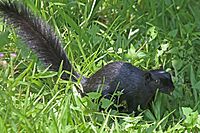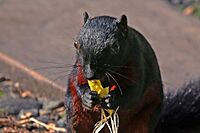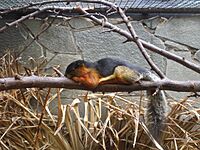Prevost's squirrel facts for kids
Quick facts for kids Prevost's squirrel |
|
|---|---|
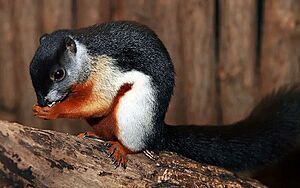 |
|
| Typical form of Prevost's squirrel | |
| Conservation status | |
| Scientific classification | |
| Genus: |
Callosciurus
|
| Species: |
prevostii
|
| Subspecies | |
|
See text |
|
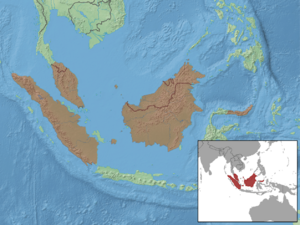 |
|
| Distribution in red | |
The Prevost's squirrel, also known as the Asian tri-coloured squirrel (scientific name: Callosciurus prevostii), is a very colorful type of rodent (like a mouse or rat, but often bigger) that belongs to the squirrel family. You can find these beautiful squirrels living in the forests of places like the Malay Peninsula, Sumatra, Borneo, and other small islands nearby. They have also been brought to northern Sulawesi by people.
Even though their homes are shrinking in some areas because of habitat loss and hunting, Prevost's squirrels are not currently considered an endangered species. This is because they are still quite common and live in many places. They can even live in areas where the forest has been changed a bit, and they often visit farms or gardens. These squirrels mostly eat plants, especially fruits, but they also enjoy munching on insects.
Contents
What Does a Prevost's Squirrel Look Like?
The Prevost's squirrel is a medium-sized squirrel. It's one of the bigger squirrels in its home area, but not as large as the giant squirrels or giant flying squirrels.
From its head to the base of its tail, a Prevost's squirrel is usually about 20 to 27 centimeters (8 to 11 inches) long. Its tail is about the same length as its body. These squirrels typically weigh between 250 and 500 grams (0.5 to 1.1 pounds). Squirrels living on smaller islands tend to be smaller, while those on large islands might be bigger.
Different Types and Colors (Subspecies)
Prevost's squirrels come in many different colors and patterns, depending on where they live. These different types are called subspecies. While there are many color differences between regions, even squirrels from the same area can look a little different from each other.
The belly of a Prevost's squirrel is always a shade of reddish-orange to a deep reddish-brown. The most common type, found in the Malay Peninsula, is one of the most colorful mammals in the world! It has a black back and tail, a reddish-orange belly, whitish fur on its upper legs and sides, and grey or grey-white cheeks.
Other subspecies can look quite similar. For example, some from southern Sumatra have grey cheeks, and others from eastern Sumatra have black cheeks. However, many subspecies look very different. In northern, central, and eastern Borneo, some squirrels have grey or olive-grey upper legs, orange cheeks, or a greyish tail.
There are also four unique subspecies that are mostly dark and have only two main colors. These squirrels are black on their back, tail, upper legs, and cheeks, and they have a rich reddish-brown belly.
Scientists have named as many as 44 different subspecies of the Prevost's squirrel over time. However, more recent studies usually recognize fewer. For example, one important book in 2005 only listed 6 subspecies. Another book in 2012 recognized 32. It's still a bit unclear exactly how many subspecies there are, especially in Borneo, and scientists are still working to figure it out.
How Prevost's Squirrels Live
Prevost's squirrels are active during the day. They spend most of their time in trees, only coming down to the ground occasionally.
Reproduction and Life Cycle
After being pregnant for about seven weeks, a mother squirrel will give birth to 1 to 3 babies. The nest where the babies are born is built from sticks, tree bark, and grass.
What Do Prevost's Squirrels Eat?
These squirrels have a varied diet. They eat many things like fruits, nuts, seeds, buds, and flowers. They also eat insects and even bird eggs.
They have been seen eating large, spiky fruits called durians. When they eat fruits, these squirrels often carry them away from the parent tree. After they finish their meal, they drop the seeds. This is very helpful for the plants! By dropping seeds far away, the squirrels help new plants grow in different places, which increases the chances of survival for those plant species.



